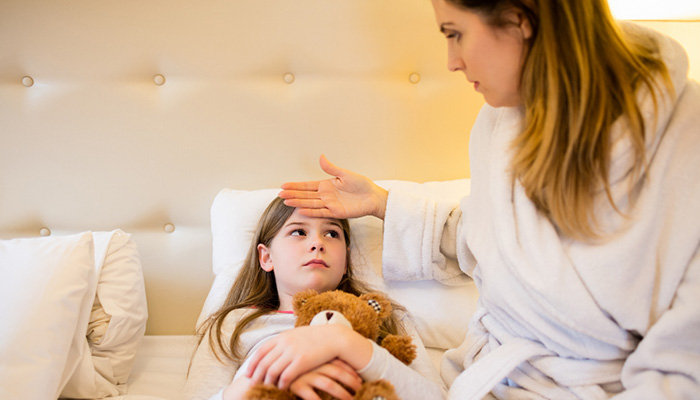Your little one catches a cold every winter and you know how distressing it is for the baby and your own self. You have heard of flu, but aren’t sure how a cold is different from a flu. Some people use the two terms interchangeably. Knowing how the two are different and how the child should be treated and cared for, will allow your child to recover from an episode.
Common cold and the flu
The common cold and flu are upper respiratory tract infections that affect the nose, ears, throat, and sinuses. Cold and flu are viral infections that spread easily. The influenza viruses, of which type A, type B, and type C strains have been identified, are responsible for both the common cold and the flu. To develop new strains, these viruses are continually changing their structure. This is why both children and adults experience several episodes of the typical cold and flu.
Difference between cold and flu
Since both conditions affect the upper respiratory system and have similar symptoms, it may be difficult to distinguish between the common cold and the flu. However, there are differences in the two conditions on onset of symptoms and severity. Flu symptoms are more intense and begin more suddenly than cold symptoms do. The child may develop a high fever which may be accompanied by chills, and the child may appear exhausted and fatigued. The child may complain of frequent body aches and headaches. The child may refuse to eat and the small babies are difficult to feed. Depending on the severity of the condition, the symptoms may change. No stuffy or runny nose should be simply attributed to yet another episode of cold. Several bacteria might produce similar symptoms, which may then develop into pneumonia by affecting and destroying the lung tissues.
The majority of colds and the flu last a few days to a week before resolving on their own without any special care. This is manageable at home and shouldn’t cause too much anxiety. One should keep an eye out for any symptoms of a condition deteriorating, though. You should seek medical attention if your kid starts breathing irregularly, noisily, or laboriously, develops a very high temperature, or starts coughing up blood.
Caring for your child
Comforting care can help the child feel better. The child needs to get a lot of rest. It is a good idea to keep the child home away from daycare or school. Small newborns should be supported upright so that they may breathe well while resting or sleeping. The older kids can be given regular sips of water, their preferred juice, or popsicles while the newborns should be breastfed. The child has to eat a nutritious, well-balanced diet. The child’s room should be kept at a reasonable temperature, and the humidity should be kept under control to prevent the air from becoming too dry. You may use humidifiers or mist to add moisture to the air, which may help with congestion and stuffiness sensations and ease breathing. The child might have a soothing warm water bath or get a warm cloth scrubbed on them. To remove the obstruction, saline nasal drops can be inserted into each nostril. Encourage the child to blow their noses into a fresh handkerchief. When a baby is extremely little, a suction bulb can be used to clean their nose. You shouldn’t insert the nozzle inside.
Medications
There are over-the-counter syrups with medications like paracetamol or ibuprofen. These can be administered to a sick child who starts to experience uncomfortable body pains or a fever. These medications can be taken precisely by the dosage recommendations. Some medications are dosed based on the children’s weight. In that situation, it is preferable to be aware of the child’s weight. These work best when utilised in children older than two. Infants younger than 2 years old should be given any medication only after consulting a doctor. Other medications for colds and flu may be provided, such as diphenhydramine and chlorphenamine, both of which are antihistamines. Histamine is a chemical signal that causes a runny nose, itchy throat, and ears. Cough suppressants may be used to help if dry coughing is a concern. Expectorants are drugs that reduce the viscosity of the secretions, enabling the child to cough them out readily. Pseudoephedrine and phenylephrine are nasal decongestant medications that help to relieve a blocked nose.
One medication that should be avoided in children is aspirin. Reye’s syndrome, a potentially fatal condition that affects the brain, liver, and other organs, may result from the usage of aspirin in children.
Visiting the doctor
With careful treatment at home, the majority of cases of the common cold and flu resolve within a few days. However, it may be important to see a doctor if the child develops a high fever, the cough lasts for several days and is accompanied by sputum that is coloured green or yellow, the child experiences laboured breathing, yellow or green nasal discharge, ear or nose pain, a severely inflamed throat, a change in voice pitch, retractions of the chest wall accompanied by breathing movements, and persistent feeding refusal.
Preventing cold and flu
The common cold and flu may spread from one person to another and are infectious. Any individual who is unwell should be kept away from the child. Children frequently become sick in the crèche or nursery. Allow a sick child to rest at home. It is important to promote appropriate hand washing on a regular basis. After every use of the toilet, before and after meals, hands should be washed with lukewarm water and soap, making sure to scrub your hands well on both surfaces, in between your fingers and between your nails for around 20 seconds. Never reuse the tissues used to clean the child’s cheeks and nose. Other children shouldn’t be given access to these, and they should be carefully disposed of in the trash. Every time you change a baby’s nappy, wash your hands. To prevent spreading their illness to children and others at home, anybody who has a cold should cough or sneeze while covering their nose and mouth with a clean handkerchief. The home has to be maintained clean and well-ventilated.
Every year, a seasonal vaccine is advised for the virus strain that causes the disease most frequently. Anyone older than six months should receive the vaccination. It is recommended that those who care for infants less than six months should be vaccinated. The influenza vaccination for 2010–2011 provides protection against the influenza A H3N2 strain. Healthcare providers and children who are at risk of infections are advised to get a vaccination.
Outlook
Warm and loving care can help a child recover from a common cold or flu. Though contagious, these illnesses can be prevented by maintaining hygiene and observing precautions.



